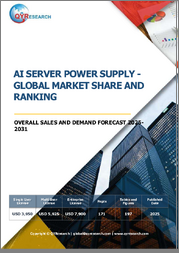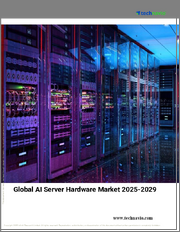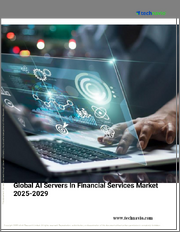
|
시장보고서
상품코드
1772320
미국의 AI 서버 시장 규모, 점유율, 동향 분석 리포트 : 프로세서 유형별, 냉각 기술별, 폼팩터별, 최종 용도별, 부문별 예측(2025-2030년)U.S. AI Server Market Size, Share & Trends Analysis Report By Processor Type (GPU-based Servers, FPGA-based Servers), By Cooling Technology (Air Cooling, Liquid Cooling), By Form Factor, By End-use, And Segment Forecasts, 2025 - 2030 |
||||||
미국의 AI 서버 시장 규모·동향 :
미국의 AI 서버 시장 규모는 2024년에 344억 2,000만 달러로 추계되며, 2025-2030년에 CAGR 37.1%로 성장할 것으로 예측됩니다.
미국의 AI 서버 산업은 헬스케어, 금융, 자동차 등 다양한 분야에서 인공지능에 대한 수요 증가에 힘입어 빠르게 성장하고 있습니다. 기업은 점점 더 복잡해지는 AI 워크로드, 특히 머신러닝과 딥러닝을 수반하는 워크로드를 지원하기 위해 첨단 서버 인프라에 많은 투자를 하고 있습니다. 이 시장은 GPU가 탑재된 고성능 컴퓨팅 시스템 등 AI에 최적화된 다양한 서버를 제공하는 주요 기술 기업이 강세를 보이고 있습니다.
클라우드 서비스 프로바이더와 데이터센터 사업자들은 AI 기능 확장에 중요한 역할을 하고 있으며, 냉각 기술 및 에너지 효율 설계의 혁신은 서버 성능을 지속적으로 향상시키고 있습니다. 엣지 컴퓨팅과 AI 추론 용도의 부상도 서버 설계 및 도입 전략에 영향을 미치고 있으며, 미국은 AI 서버 기술의 세계 리더로서 입지를 다지고 있습니다.
CHIPS와 NAIRR과 같은 미국 연방정부 구상은 국내 AI 인프라에 수십억 달러를 투자하고 있습니다. 이러한 정책은 국가 경쟁력을 강화하고, AI 연구개발을 강화하며, 외국산 하드웨어에 대한 의존도를 줄이는 것을 목표로 하고 있습니다. 그 결과, 민관 파트너십을 통해 학계, 국방, 국립 연구소 환경에서의 AI 서버 배치가 가속화되고 다양한 분야에서 수요가 확대되고 있습니다.
또한 미국내 AI 도입은 수직적으로 진행되고 있으며, 농업, 법률 기술, 물류, 에너지 등의 산업에서 자체적인 AI 모델을 개발하고 있습니다. 이러한 분야별 용도의 경우, 틈새 성능 요건을 충족하기 위해 최적화된 메모리 대역폭, 스토리지 솔루션, 열 관리 등 맞춤형 서버 구성이 필요합니다. 미국에 본사를 둔 OEM 및 통합업체들은 이러한 특수한 워크로드에 특화된 모듈형 AI 서버 아키텍처를 제공함으로써 이러한 요구에 대응하고 있습니다.
또한 지속가능성은 미국내 서버 조달 의사결정에 있으며, 중요한 요소로 자리 잡고 있습니다. 기업 및 클라우드 프로바이더들은 ESG 목표와 탄소배출량 규제 강화에 따라 에너지 효율이 높은 AI 서버에 투자하고 있습니다. 미국 데이터센터는 액체 냉각, AI를 활용한 워크로드 최적화, 재생에너지 통합을 도입하고 있으며, 그린 컴퓨팅을 지원하는 AI 서버에 대한 수요가 증가하고 있습니다.
헬스케어, 금융, 통신, 소매 등의 분야에서 AI 기술을 통합하여 업무와 고객 경험을 강화하려는 움직임이 가속화되고 있습니다. 이러한 용도를 지원하는 고성능 컴퓨팅의 필요성이 AI 서버에 대한 수요를 촉진하고 있습니다. 또한 AI 연구개발을 촉진하기 위한 미국 정부의 정책 및 자금 지원은 혁신을 촉진하고 AI 기술 채택을 가속화하여 AI 서버 인프라에 대한 수요를 촉진하고 있습니다.
목차
제1장 조사 방법과 범위
제2장 개요
제3장 미국의 AI 서버 변수, 동향, 범위
- 시장 서론/계통 전망
- 업계 밸류체인 분석
- 시장 역학
- 시장 성장 촉진요인 분석
- 시장 성장 억제요인 분석
- 업계의 기회
- AI 서버 분석 툴
- Porter의 산업 분석
- PESTEL 분석
제4장 미국의 AI 서버 : 프로세서 유형별 추정·동향 분석
- 부문 대시보드
- 미국의 AI 서버 시장 : 프로세서 유형별 변동 분석, 2024년·2030년
- GPU 기반 서버
- FPGA 기반 서버
- ASIC 기반 서버
제5장 미국의 AI 서버 : 냉각 기술별 추정·동향 분석
- 부문 대시보드
- 미국의 AI 서버 시장 : 냉각 기술별 변동 분석, 2024년·2030년
- 공랭
- 액랭
- 하이브리드 냉각
제6장 미국의 AI 서버 : 폼팩터별 추정·동향 분석
- 부문 대시보드
- 미국의 AI 서버 시장 : 폼팩터별 변동 분석, 2024년·2030년
- 랙 마운트형 서버
- 블레이드 서버
- 타워 서버
제7장 미국의 AI 서버 : 최종 용도별 추정·동향 분석
- 부문 대시보드
- 미국의 AI 서버 시장 : 최종 용도별 변동 분석, 2024년·2030년
- IT·통신
- BFSI
- 소매·E-Commerce
- 헬스케어·의약품
- 자동차
- 기타
제8장 경쟁 구도
- 주요 시장 참여 기업에 의한 최근 동향과 영향 분석
- 기업 분류
- 기업 시장 점유율 분석, 2024년
- 기업 히트맵 분석
- 전략 지도제작
- 확대
- 합병과 인수
- 파트너십과 협업
- 제품 발매
- 최근 동향
- 기업 개요
- Dell Technologies
- Hewlett-Packard Enterprise(HPE)
- IBM Corporation
- NVIDIA Corporation
- Super Micro Computer, Inc.
- Intel Corporation
- Lenovo Group Limited
- Cisco Systems, Inc.
- ADLINK Technology Inc.
- Advanced Micro Devices, Inc.(AMD)
U.S. AI Server Market Size & Trends:
The U.S. AI server market size was estimated at USD 34.42 billion in 2024 and is projected to grow at a CAGR of 37.1% from 2025 to 2030. The U.S. AI server industry is experiencing rapid expansion, driven by growing demand for artificial intelligence across sectors such as healthcare, finance, and automotive. Companies are investing heavily in advanced server infrastructure to support increasingly complex AI workloads, particularly those involving machine learning and deep learning. The market is characterized by the strong presence of leading technology firms that offer a broad range of AI-optimized servers, including GPU-powered and high-performance computing systems.
Cloud service providers and data center operators are playing a critical role in scaling AI capabilities, while innovation in cooling technologies and energy-efficient designs continues to enhance server performance. The rise of edge computing and AI inference applications is also influencing server design and deployment strategies, positioning the U.S. as a global leader in AI server technology.
U.S. federal initiatives, such as the CHIPS and Science Act and National AI Research Resource (NAIRR), are investing billions into domestic AI infrastructure. These policies aim to strengthen national competitiveness, bolster AI R&D, and reduce dependency on foreign hardware. As a result, public-private partnerships are accelerating the deployment of AI servers in academic, defense, and national lab environments, expanding demand across various sectors.
In additionally, AI adoption in the U.S. is increasingly verticalized, with industries like agriculture, legal tech, logistics, and energy developing tailored AI models. These domain-specific applications require customized server configurations including optimized memory bandwidth, storage solutions, and thermal management to meet niche performance requirements. U.S.-based OEMs and integrators are responding by offering modular AI server architectures purpose-built for these specialized workloads.
Moreover, sustainability has become a critical factor in U.S. server procurement decisions. Enterprises and cloud providers are investing in energy-efficient AI servers to align with ESG goals and rising regulatory scrutiny around carbon emissions. U.S. data centers are increasingly adopting liquid cooling, AI-powered workload optimization, and renewable energy integration, creating demand for AI servers that support green computing practices.
Sectors such as healthcare, finance, telecommunications, and retail are increasingly integrating AI technologies to enhance operations and customer experiences. The need for high-performance computing to support these applications is driving the demand for AI servers. In addition, U.S. government policies and funding aimed at promoting AI research and development are fostering innovation and accelerating the adoption of AI technologies, thereby boosting the demand for AI server infrastructure.
U.S. AI Server Market Report Segmentation
This report forecasts revenue growth at global, regional, and country levels and provides an analysis of the latest industry trends in each of the sub-segments from 2018 to 2030. For this study, Grand View Research has segmented the U.S. AI server market report based on processor type, cooling technology, form factor, and end-use.
- Processor Type Outlook (Revenue, USD Billion, 2018 - 2030)
- GPU-based Servers
- FPGA-based Servers
- ASIC-based Servers
- Cooling Technology Outlook (Revenue, USD Billion, 2018 - 2030)
- Air Cooling
- Liquid Cooling
- Hybrid Cooling
- Form Factor Outlook (Revenue, USD Billion, 2018 - 2030)
- Rack-mounted Servers
- Blade Servers
- Tower Servers
- End-use Outlook (Revenue, USD Billion, 2018 - 2030)
- IT & Telecommunication
- BFSI
- Retail & E-commerce
- Healthcare & Pharmaceutical
- Automotive
- Others
Table of Contents
Chapter 1. Methodology and Scope
- 1.1. Market Segmentation and Scope
- 1.2. Market Definitions
- 1.3. Research Methodology
- 1.3.1. Information Procurement
- 1.3.2. Information or Data Analysis
- 1.3.3. Market Formulation & Data Visualization
- 1.3.4. Data Validation & Publishing
- 1.4. Research Scope and Assumptions
- 1.4.1. List of Data Sources
Chapter 2. Executive Summary
- 2.1. Market Outlook
- 2.2. Segment Outlook
- 2.3. Competitive Insights
Chapter 3. U.S. AI Server Variables, Trends, & Scope
- 3.1. Market Introduction/Lineage Outlook
- 3.2. Industry Value Chain Analysis
- 3.3. Market Dynamics
- 3.3.1. Market Drivers Analysis
- 3.3.2. Market Restraints Analysis
- 3.3.3. Industry Opportunities
- 3.4. AI Server Analysis Tools
- 3.4.1. Porter's Analysis
- 3.4.1.1. Bargaining power of the suppliers
- 3.4.1.2. Bargaining power of the buyers
- 3.4.1.3. Threats of substitution
- 3.4.1.4. Threats from new entrants
- 3.4.1.5. Competitive rivalry
- 3.4.2. PESTEL Analysis
- 3.4.2.1. Political landscape
- 3.4.2.2. Economic and Social landscape
- 3.4.2.3. Technological landscape
- 3.4.2.4. Environmental landscape
- 3.4.2.5. Legal landscape
- 3.4.1. Porter's Analysis
Chapter 4. U.S. AI Server: Processor Type Estimates & Trend Analysis
- 4.1. Segment Dashboard
- 4.2. U.S. AI Server Market: Processor Type Movement Analysis, 2024 & 2030 (USD Billion)
- 4.3. GPU-based Servers
- 4.3.1. Market Size Estimates and Forecasts, 2018 - 2030 (USD Billion)
- 4.4. FPGA-based Servers
- 4.4.1. Market Size Estimates and Forecasts, 2018 - 2030 (USD Billion)
- 4.5. ASIC-based Servers
- 4.5.1. Market Size Estimates and Forecasts, 2018 - 2030 (USD Billion)
Chapter 5. U.S. AI Server: Cooling Technology Estimates & Trend Analysis
- 5.1. Segment Dashboard
- 5.2. U.S. AI Server Market: Cooling Technology Movement Analysis, 2024 & 2030 (USD Billion)
- 5.3. Air Cooling
- 5.3.1. Market Size Estimates and Forecasts, 2018 - 2030 (USD Billion)
- 5.4. Liquid Cooling
- 5.4.1. Market Size Estimates and Forecasts, 2018 - 2030 (USD Billion)
- 5.5. Hybrid Cooling
- 5.5.1. Market Size Estimates and Forecasts, 2018 - 2030 (USD Billion)
Chapter 6. U.S. AI Server: Form Factor Estimates & Trend Analysis
- 6.1. Segment Dashboard
- 6.2. U.S. AI Server Market: Form Factor Movement Analysis, 2024 & 2030 (USD Billion)
- 6.3. Rack-mounted Servers
- 6.3.1. Market Size Estimates and Forecasts, 2018 - 2030 (USD Billion)
- 6.4. Blade Servers
- 6.4.1. Market Size Estimates and Forecasts, 2018 - 2030 (USD Billion)
- 6.5. Tower Servers
- 6.5.1. Market Size Estimates and Forecasts, 2018 - 2030 (USD Billion)
Chapter 7. U.S. AI Server: End Use Estimates & Trend Analysis
- 7.1. Segment Dashboard
- 7.2. U.S. AI Server Market: End Use Movement Analysis, 2024 & 2030 (USD Billion)
- 7.3. IT & Telecommunication
- 7.3.1. Market Size Estimates and Forecasts, 2018 - 2030 (USD Billion)
- 7.4. BFSI
- 7.4.1. Market Size Estimates and Forecasts, 2018 - 2030 (USD Billion)
- 7.5. Retail & E-commerce
- 7.5.1. Market Size Estimates and Forecasts, 2018 - 2030 (USD Billion)
- 7.6. Healthcare & Pharmaceutical
- 7.6.1. Market Size Estimates and Forecasts, 2018 - 2030 (USD Billion)
- 7.7. Automotive
- 7.7.1. Market Size Estimates and Forecasts, 2018 - 2030 (USD Billion)
- 7.8. Others
- 7.8.1. Market Size Estimates and Forecasts, 2018 - 2030 (USD Billion)
Chapter 8. Competitive Landscape
- 8.1. Recent Developments & Impact Analysis by Key Market Participants
- 8.2. Company Categorization
- 8.3. Company Market Share Analysis, 2024
- 8.4. Company Heat Map Analysis
- 8.5. Strategy Mapping
- 8.5.1. Expansion
- 8.5.2. Mergers & Acquisition
- 8.5.3. Partnerships & Collaborations
- 8.5.4. Product Launches
- 8.5.5. Recent Developments
- 8.6. Company Profiles
- 8.6.1. Dell Technologies
- 8.6.1.1. Participant's Overview
- 8.6.1.2. Financial Performance
- 8.6.1.3. Product Benchmarking
- 8.6.1.4. Recent Developments
- 8.6.2. Hewlett-Packard Enterprise (HPE)
- 8.6.2.1. Participant's Overview
- 8.6.2.2. Financial Performance
- 8.6.2.3. Product Benchmarking
- 8.6.2.4. Recent Developments
- 8.6.3. IBM Corporation
- 8.6.3.1. Participant's Overview
- 8.6.3.2. Financial Performance
- 8.6.3.3. Product Benchmarking
- 8.6.3.4. Recent Developments
- 8.6.4. NVIDIA Corporation
- 8.6.4.1. Participant's Overview
- 8.6.4.2. Financial Performance
- 8.6.4.3. Product Benchmarking
- 8.6.4.4. Recent Developments
- 8.6.5. Super Micro Computer, Inc.
- 8.6.5.1. Participant's Overview
- 8.6.5.2. Financial Performance
- 8.6.5.3. Product Benchmarking
- 8.6.5.4. Recent Developments
- 8.6.6. Intel Corporation
- 8.6.6.1. Participant's Overview
- 8.6.6.2. Financial Performance
- 8.6.6.3. Product Benchmarking
- 8.6.6.4. Recent Developments
- 8.6.7. Lenovo Group Limited
- 8.6.7.1. Participant's Overview
- 8.6.7.2. Financial Performance
- 8.6.7.3. Product Benchmarking
- 8.6.7.4. Recent Developments
- 8.6.8. Cisco Systems, Inc.
- 8.6.8.1. Participant's Overview
- 8.6.8.2. Financial Performance
- 8.6.8.3. Product Benchmarking
- 8.6.8.4. Recent Developments
- 8.6.9. ADLINK Technology Inc.
- 8.6.9.1. Participant's Overview
- 8.6.9.2. Financial Performance
- 8.6.9.3. Product Benchmarking
- 8.6.9.4. Recent Developments
- 8.6.10. Advanced Micro Devices, Inc. (AMD)
- 8.6.10.1. Participant's Overview
- 8.6.10.2. Financial Performance
- 8.6.10.3. Product Benchmarking
- 8.6.10.4. Recent Developments
- 8.6.1. Dell Technologies
(주말 및 공휴일 제외)


















